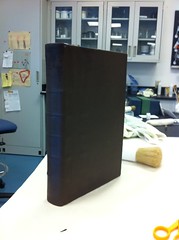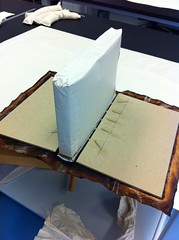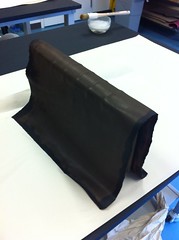Smooth leather overall, allow to dry
Monday, June 27, 2011
Monday, June 20, 2011
Arcadia and the shadow of a louse
I saw the play Arcadia the other week. The setting is the manor house Sidley Park, in two different time periods, 1809-1812 and the present day. The action of the present day involves two academics and their research to prove theories about what happened at the house in the past. Hannah Jarvis is researching a person she has named "the Sidley Park Hermit", her belief in his existence is largely based on a drawing of him in the landscape picture book of the manor house grounds. However, the audience has seen Thomasina Coverly (in 1809) draw the hermit in the book as a joke on the landscape architect Mr. Noakes.
Bernard Nightingale is trying to prove that Lord Byron left England in 1809 because he shot a Mr. Crater (a guest at Sidley Park) in a duel. Nightingale can place Lord Byron at Sidley Park thanks to a notation in the game book, but he can't prove the Crater connection. Again the audience has seen "what really happened" in a previous scene and knows the duel was between Crater and Septimus Hodge, Thomasina's tutor and that Crater survived.
Jarvis refuses to publicize her theories until she has proof, while Nightingale goes ahead and lectures on his theory with only the evidence from the game book to back him up. The action of the play eventually reveals that Nightingale's theory is incorrect while Jarvis finds proof of her hermit.
As a conservator, I see a lot of tantalizing clues when I take a book apart. Watermarks are easier to compare and document when the book is apart and each page can be placed over a light sheet. Plates can be examined more closely when laid flat on a bench. I can see many traces of where the binder, printer and perhaps author made choices about a book's production.
For example, the plate of the cheese mites; when I examined it closely, I noticed that the end of the caption over each print had been scraped away, with a teeny bit of printer's ink remaining. I can't make out what had been printed there, but it is clear that something has been scraped away. I'm kicking myself now because when I examined the Folger Library's copy of the 1667 edition, I didn't take a picture of the cheese mites plate and now I can't compare the captions. Could the UVa 1667 copy be a printers proof? based on the cheese mites plate, and the fact the UVa flea plate has some of the reference letters engraved backwards, I'm starting to wonder, and again, I don't have a photo of the flea plate from the Folger copy for reference.
Which brings me to the shadow of a louse. Or rather the fact that the UVa plate has a louse that does not cast a shadow and is the only example that I can find of this particular version of the plate. I examined the Folger 1667 Micrographia and the Chemical Heritage Foundation's 1665 Micrographia and in both books their louse casts a shadow (see the Folger's louse below). I also sent inquiries to the Smithsonian's Dibner Library regarding their 1665 copy and received word from the Library Company that their copies of the 1745 "Restaurata" edition all had plates with a louse that cast a shadow.
There are other differences in the louse plates and I am extremely grateful to the staff at the various libraries who have helped me pin down the details.
Labels:
Arcadia,
book conservation,
conservation,
louse,
micrographia,
robert hooke
Subscribe to:
Posts (Atom)




